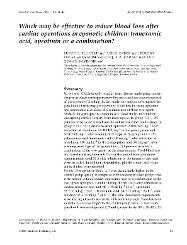Which may be effective to reduce blood loss after cardiac operations in cyanotic children: tranexamic acid aprotinin or a combination?
Abstract
Background: Children with cyanotic heart disease undergoing cardiac surgery in which cardiopulmonary bypass is used are at increased risk of postoperative bleeding. In this study the authors investigated the possibility of reducing postoperative blood loss by using aprotinin and tranexamic acid alone or a combination of these two agents. Methods: In a prospective randomized blind study 100 children undergoing cardiac surgery were investigated. In group 1 (n = 25) patients acted as the control and did not receive either study drugs. In group 2 (n = 25) patients received aprotinin (30.000 KIU.kg(-1) after induction of anesthesia 30.000 KIU.kg(-1) in the pump prime and 30.000 KIU.kg(-1) after weaning from bypass). In group 3 (n = 25) patients received tranexamic acid (100 mg.kg(-1) after induction of anesthesia 100 mg.kg(-1) in the pump prime and 100 mg.kg(-1) after weaning from bypass). In group 4 (n = 25) patients received a combination of the two agents in the same manner. Total blood loss and transfusion requirements during the period from protamine administration until 24 h after admission to the intensive care unit were recorded. In addition hemoglobin platelet counts and coagulation studies were recorded. Results: Postoperative blood loss was significantly higher in the control group (group 1) compared with children in other groups who were treated with aprotinin tranexamic acid or a combination of the two agents (groups 2 3 and 4) during the first 24 h after admission to cardiac intensive care unit (40 +/- 18 ml.kg(-1).24 h(-1) aprotinin 35 +/- 16 ml.kg(-1).24 h(-1) tranexamic acid 34 +/- 19 ml.kg(-1).24 h(-1) combination 35 +/- 15 ml.kg(-1).24 h(-1)). The total transfusion requirements were also significantly less in the all treatment groups. Time taken for sternal closure was longer in the control group (68 +/- 11 min) compared with treatment groups 2 3 and 4 respectively (40 +/- 18 42 +/- 11 42 +/- 13 min P < 0.05). The coagulation parameters were not found to be significantly different between the three groups. Conclusions: Our results suggested that both agents were effective to reduce postoperative blood loss and transfusion requirements in patients with cyanotic congenital heart disease. However the combination of aprotinin and tranexamic acid did not seem more effective than either of the two drugs alone.
















